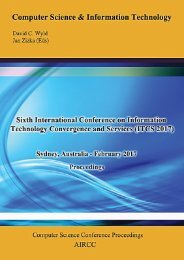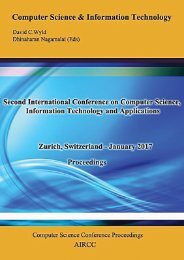CoSIT 2017
Fourth International Conference on Computer Science and Information Technology ( CoSIT 2017 ), Geneva, Switzerland - March 2017
Fourth International Conference on Computer Science and Information Technology ( CoSIT 2017 ), Geneva, Switzerland - March 2017
Create successful ePaper yourself
Turn your PDF publications into a flip-book with our unique Google optimized e-Paper software.
138 Computer Science & Information Technology (CS & IT)<br />
between results), we tried to incorporate the uncertainties to explain the variability and we are not<br />
aware of any other factors that could bias the results.<br />
External Validity. Six different projects from different companies and several industries were<br />
examined in this study. Our approach can be applied to almost any data set of defects, with a wide<br />
range of diversity. However, a possible threat is that the data sets in this study were all taken from<br />
the same implementation of ALM. Further studies on different systems are desirable to verify our<br />
findings.<br />
Reliability Validity. The dataset used in the work is commercial so cannot be publicly accessible<br />
for the moment and therefore this work cannot be replicated by other researchers using the exact<br />
dataset. However, we made a significant effort to provide all relevant implementation details.<br />
8. SUMMARY<br />
In this paper, we presented a novel approach for prediction of software defect handling time by<br />
applying data mining techniques on historical defects. We designed and implemented a generic<br />
system that extracts defect information, applies preprocessing, and uses a random forest<br />
regression algorithm to train a prediction model. We applied our method on six projects of<br />
different customers from different industries, with promising results. Our system was designed to<br />
handle flaws in the data sets common in real-life scenarios, such as missing and noisy data.<br />
9. FUTURE WORK<br />
We currently do not sufficiently exploit the content of the free-text fields. We would like to use<br />
text mining techniques to extract key terms that affect the defect handling time.<br />
We are also considering an expanded approach based on state transition models, in which we<br />
calculate the probability of a defect transitioning between any given pair of states during a certain<br />
time period. A similar idea was described in [18] but we want to expand this idea by computing a<br />
separate model for each defect, based on its fields, rather than assuming that all defects behave<br />
identically. This could be used to make a large number of predictions about defect life-cycle, for<br />
example, to predict how many defects will be reopened. Combining this with methods used for<br />
defect injection rates, such as those surveyed in [19], may provide a more realistic prediction for<br />
the situation in which new defects are detected within the project time-frame.<br />
Our algorithm can be easily generalized to other entities representing work to be done, such as<br />
product requirements and production incidents, and we would like to evaluate its accuracy in<br />
these cases. We plan to also generalize our system to extract data from different defect reporting<br />
systems.<br />
To make our data publicly available to be used by related research, we plan to obfuscate our data<br />
set by removing any identifiable or private information and publish it.





